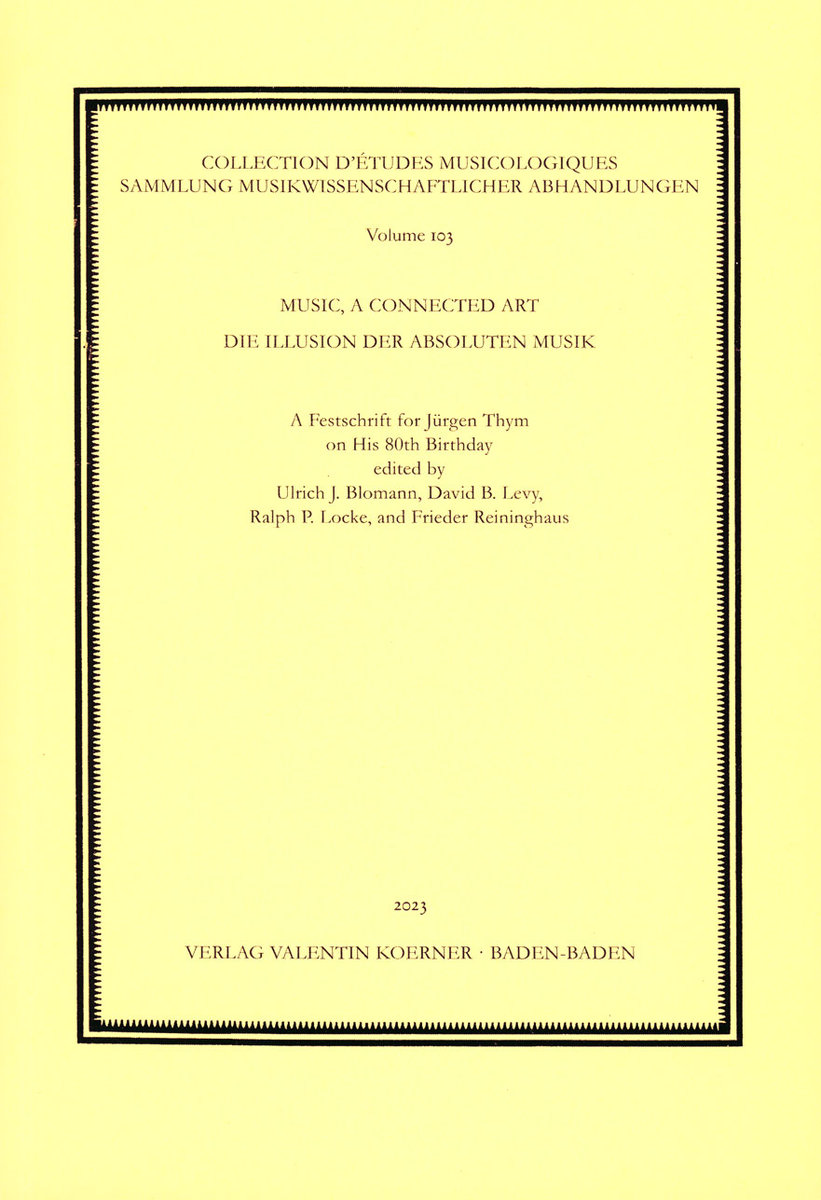 Music, A Connected Art / Die Illusion der absoluten Musik: A Festschrift for Jürgen Thym on His 80th Birthday. Ed. Ulrich J. Blomann, David B. Levy, Ralph P. Locke, and Frieder Reininghaus. Baden-Baden: Verlag Valentin Koerner, 2023. 368 pp. 25 illustrations, 35 music examples, and 2 compositions. ISBN: 9783873206038. € 78.
Music, A Connected Art / Die Illusion der absoluten Musik: A Festschrift for Jürgen Thym on His 80th Birthday. Ed. Ulrich J. Blomann, David B. Levy, Ralph P. Locke, and Frieder Reininghaus. Baden-Baden: Verlag Valentin Koerner, 2023. 368 pp. 25 illustrations, 35 music examples, and 2 compositions. ISBN: 9783873206038. € 78.
Festschrifts can, at their best, contribute to scholarship while also tracing networks of influence, mentorship, and friendship. Music: A Connected Art / Die Illusion der absoluten Musik accomplishes all of that and more. The contributors interweave musical insights with their tributes to Jürgen Thym as mentor and colleague. In keeping with Thym’s research interests, many chapters explore the performance, analysis, and translation of German art song (e.g. Susan Youens’s elegant and witty essay “Translating a Winter’s Journey: Crossing Cultural Boundaries” on the first French translation of Schubert’s Winterreise). Readers in other fields will find much of interest as well. The volume covers a broad repertoire ranging from seventeenth-century Venice (e.g. Kerala J. Snyder on Simone Vesi’s vesper music) to twentieth-century American music (including chapters on John Cage, William Albright, and Broadway musicals) and even a chapter on twenty-first-century Faustian operas. The authors comprise a diverse group of musicologists, theorists, and performers. Moreover, linguistic diversity is represented with a handful of contributions in German. The volume is structured in six sections addressing the nature of music, music and poetry, music and theater/opera/film, music-making in time and place, music and the individual composer’s voice, and greetings and reminiscences for Thym. Each section offers new variations on the “key words [sic] in the book’s double-title-Music/Musik, connections, absoluteness as illusory” (13).
In the introduction, the editors state that “many of the writers took the opportunity (with our encouragement) to adopt an approach more essayistic than is normal in musicological prose” (14). The essay genre lends itself to freedom, playfulness, and exploration (Adorno 1984, 164-65) and allows for interdisciplinary hypotheses. Thus we encounter scientific thinking about evolution (Ulrich J. Blomann, “On the Origin of Music: A Hypothesis”) and cognitive approaches to listening (Wilfried Gruhn, “Warum wir hören, was wir hören: Neuropsychologische Aspekte musikalischer Wahrnehmung”). Several authors propose innovative rehearings of well-known works. For instance, Yonatan Malin’s chapter, “Poetic Endings and Song Endings in ‘Gute Nacht’ and ‘Der Leiermann’ from Schubert’s Winterreise,” rethinks standard definitions of musical and textual closure. The prevailing spirit of risk-taking proves especially rewarding in Seth Brodsky’s juxtaposition of Schubert’s “der Doppelgänger” with the 1791 Haitian revolution. Brodsky pays tribute to his musicological training under Thym while boldly inviting us to imagine Haiti, and not France, as the epicenter of eighteenth-century rebellion.
Like Brodsky, several of the authors engage with global and vernacular traditions alongside Western Art Music. Approaches to teaching beyond the canon include Ralph P. Locke’s inspiring essay on “Music’s Connections: Experiences in the Classroom,” which thoughtfully recounts his advocacy for undervalued traditions such as shape-note singing in rural Alabama (240). Along similar lines, Mary Natvig’s “Teaching Beethoven Post-2020” reflects on her pedagogical response to the Black Lives Matter movement: she included works by female, transgender, and non-binary BIPOC composers in her 2021 chamber music literature course (233-34). Relatedly, gender diversity comes to the forefront in Matthew Valverde’s “‘Whose Spinnrad Is It Anyway!?’: Deconstructing Gender Specificity in Art-Song Performance.” As a self-identified cis-gendered gay male singer, Valverde “empowers vocalists to confidently perform songs traditionally reserved for singers of a different gender” (155). Musicologists and performers, therefore, will have much to learn from perspectives on gender, race, and canonicity in this volume.
In addition to musicological and analytical contributions, several essays also shed light on North American academic culture in the 1970s and 1980s, as well as the pedagogical practices of the Eastman School of Music during Thym’s long tenure there. In particular, the closing section “Greetings and Reminiscences,” is relevant to a broad readership beyond Thym’s immediate circle, replete with interesting details about Eastman’s pedagogical histories, hiring practices, and interdisciplinary collaborations. The power of mentorship and friendship emerges as a prominent theme.
A unique feature is the inclusion of two compositional tributes to Thym, one of which is Samuel Adler’s “Bagatelle for Jürgen,” based on a cipher of the honoree’s name. This technique resonates with R. Larry Todd’s chapter on “The Musical Cryptography of Niels Gade, or, What’s in a Name?” Ciphers, as Todd persuasively argues, enact social bonds between musicians.
In conclusion, themes of friendship and influence serve to unify this volume. Its English title Music: A Connected Art carries a double meaning, signifying musical connections as well as social bonds that support scholarly research. With refreshing generosity that is all too rare in academia, many chapters pay homage to the often unsung labor of mentors and colleagues. Brodsky writes of the darkest hours of his graduate school struggles and of Thym’s inspiring words of encouragement (133); Mary Natvig thanks Thym for offering her a second chance in the Eastman Ph.D. program after her father’s ALS illness (306). Such moving accounts of vulnerability and empathy, combined with musical insights, enable this Festschrift to serve as a model for an academic ethics of care.
References
Adorno, Theodor. 1984. “The Essay as Form,” trans. Bob Hullot-Kentor and Frederic Will, New German Critique 32, 151-171.


